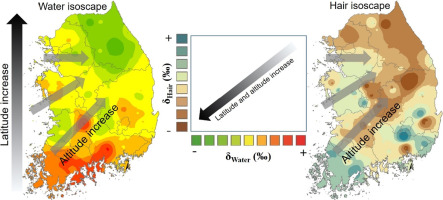当前位置:
X-MOL 学术
›
Sci. Total Environ.
›
论文详情
Our official English website, www.x-mol.net, welcomes your feedback! (Note: you will need to create a separate account there.)
Spatial variations in oxygen and hydrogen isotopes in waters and human hair across South Korea.
Science of the Total Environment ( IF 9.8 ) Pub Date : 2020-04-08 , DOI: 10.1016/j.scitotenv.2020.138365 Mukesh Kumar Gautam 1 , Byeong-Yeol Song 2 , Woo-Jin Shin 3 , Yeon-Sik Bong 3 , Kwang-Sik Lee 3
Science of the Total Environment ( IF 9.8 ) Pub Date : 2020-04-08 , DOI: 10.1016/j.scitotenv.2020.138365 Mukesh Kumar Gautam 1 , Byeong-Yeol Song 2 , Woo-Jin Shin 3 , Yeon-Sik Bong 3 , Kwang-Sik Lee 3
Affiliation

|
The spatial distribution of isotopic signatures in the form of isoscape is a valuable tool to map their spatial heterogeneity in various environmental settings. However, only limited information about δ18O and δ2H in water across South Korea is available and to our knowledge no study so far has tried to examine the isotopic heterogeneity of tap water and human scalp hair in South Korea. Here, we present the first national scale analyses of stream water, groundwater, tap water, and human scalp hair isoscapes for South Korea. Stream water, groundwater, tap water, and human scalp hair samples were collected from across South Korea. These samples were analyzed for δ18O and δ2H, and the isotopic data were then used to generate interpolated δ18O and δ2H isoscapes for South Korea. The results of linear regression analyses showed strong and significant relationships between δ18Ohair and δ18Owater (R2 = 0.83, P < 0.002) and between δ2Hhair and δ2Hwater (R2 = 0.74, P < 0.006), primarily reflecting a close co-relationship between water and hair. The slopes of linear regressions for δ18O (Δδ18Ohair/Δδ18Owater) and δ2H (Δδ2Hhair/Δδ2Hwater) suggested that approximately 27% of hydrogen and 36% of oxygen in hair keratin were derived from the local drinking water. Interpolated δ18O and δ2H isotope maps of stream water, groundwater, and tap water samples collected from across South Korea showed similar spatial patterns of isotope variability. These samples showed a clear latitudinal gradient with high isotopic values in the south which progressively decrease toward the north. The same trends were observed in hair isoscapes as well, and had gradients matching the isotopic pattern of water samples. The strong relationship between water and human hair, and the consistent spatial pattern between them suggest that hair isotope signatures in South Korea can be used in provenance- and forensic-related activities.
中文翻译:

韩国各地水域和人类头发中氧和氢同位素的空间变化。
同位素特征形式的同位素特征的空间分布是在各种环境条件下绘制其空间异质性的有价值的工具。但是,关于韩国整个水中的δ18O和δ2H的信息非常有限,据我们所知,到目前为止,尚无研究试图检验韩国自来水和人头皮头发的同位素异质性。在这里,我们展示了韩国的溪流水,地下水,自来水和人类头皮头发isoscapes的首次国家规模分析。从韩国各地收集溪流水,地下水,自来水和人类头皮头发样本。分析这些样品的δ18O和δ2H,然后使用同位素数据生成韩国的内插δ18O和δ2H等值线。线性回归分析的结果表明,δ18Ohair和δ18Owater之间(R2 = 0.83,P <0.002)以及δ2Hhair和δ2Hwater之间(R2 = 0.74,P <0.006)有很强的显着关系,主要反映了水和头发之间的紧密关联。δ18O(Δδ18Ohair/Δδ18Owater)和δ2H(Δδ2Hhair/Δδ2Hwater)的线性回归斜率表明,头发角蛋白中大约27%的氢和36%的氧气来自本地饮用水。从韩国各地收集的溪流水,地下水和自来水样品的δ18O和δ2H同位素插值图显示了类似的同位素变异性空间格局。这些样品显示出明显的纬度梯度,其南部具有较高的同位素值,向北逐渐降低。在头发等值线中也观察到了相同的趋势,并且具有与水样品的同位素模式匹配的梯度。水与人类头发之间的紧密关系以及它们之间一致的空间格局表明,韩国的头发同位素特征可用于与物产和法医相关的活动。
更新日期:2020-04-08
中文翻译:

韩国各地水域和人类头发中氧和氢同位素的空间变化。
同位素特征形式的同位素特征的空间分布是在各种环境条件下绘制其空间异质性的有价值的工具。但是,关于韩国整个水中的δ18O和δ2H的信息非常有限,据我们所知,到目前为止,尚无研究试图检验韩国自来水和人头皮头发的同位素异质性。在这里,我们展示了韩国的溪流水,地下水,自来水和人类头皮头发isoscapes的首次国家规模分析。从韩国各地收集溪流水,地下水,自来水和人类头皮头发样本。分析这些样品的δ18O和δ2H,然后使用同位素数据生成韩国的内插δ18O和δ2H等值线。线性回归分析的结果表明,δ18Ohair和δ18Owater之间(R2 = 0.83,P <0.002)以及δ2Hhair和δ2Hwater之间(R2 = 0.74,P <0.006)有很强的显着关系,主要反映了水和头发之间的紧密关联。δ18O(Δδ18Ohair/Δδ18Owater)和δ2H(Δδ2Hhair/Δδ2Hwater)的线性回归斜率表明,头发角蛋白中大约27%的氢和36%的氧气来自本地饮用水。从韩国各地收集的溪流水,地下水和自来水样品的δ18O和δ2H同位素插值图显示了类似的同位素变异性空间格局。这些样品显示出明显的纬度梯度,其南部具有较高的同位素值,向北逐渐降低。在头发等值线中也观察到了相同的趋势,并且具有与水样品的同位素模式匹配的梯度。水与人类头发之间的紧密关系以及它们之间一致的空间格局表明,韩国的头发同位素特征可用于与物产和法医相关的活动。



























 京公网安备 11010802027423号
京公网安备 11010802027423号